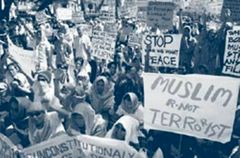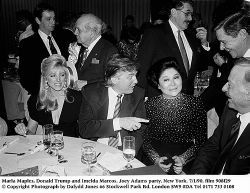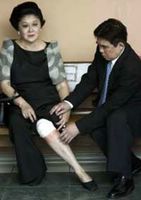Yesterday, a centuries-old war
still being fought in Sulu between adversaries bound by the unfortunate accidents of colonial history and religious identity re-opened an old front that had been silent since the
LRT bombings in 2000.
The nearly
simultaneous bombings in various Philippine urban centers including the bombing of a bus in the Makati financial district, are a reminder that "terrorism" isn't such a neat category of violence and that putting it in the same phrase as "war" oversimplifies both the notion of war and the motives of "terrorists."
 Agence France Press: Aftermath of the February 14 bombing in Makati
Agence France Press: Aftermath of the February 14 bombing in Makati In the United States, September 11, 2001 is regarded as
"the day the world changed." It is as if
previous deaths in just as massive numbers elsewhere in the world caused by ideologically-motivated acts of violence were insignificant losses of life, regrettable but forgettable. (Yet, why should these
two masssacres, carried out sixty years ago within one week of each other -- by Americans! -- be less "world-changing" than any other?) For many Americans as much as for their government, 9/11 is the the point at which the American system of government transformed itself in order to confront the phenomenon of “terrorism” associated with groups bound by an adherence to a militant Islamic perspective.
In the Philippines, however, the relationship between violence, the State, its legal system and the Muslim identity goes back to the 14th century, when the first pre-colonial inhabitants of the Sulu archipelago that now forms part of the Philippine southern Mindanao region were converted to Islam. The arrival of Spanish colonizers in the 16th century also saw the coming of what
the anthropologist Charles Frake calls “(t)he first terrorist label – Moro.” The “Moro” label was attached by the Spanish colonizers to the indigenous Muslims not only because of the common belief they shared with the Moors who once occupied Spain, but also because of the armed resistance they put up against Spanish (and later, American) colonial government. This armed conflict with Spanish colonizers was not limited to the southern Mindanao region; it extended to parts of what are now Brunei, Malaysia and Indonesia.

The area of that conflict of more than 500 years ago is now reflected in the Southeast Asian version of the United States’ so-called “war on terrorism,” which also encompasses Singapore and parts of southern Thailand. This should be a sobering fact in dissecting how Islamic “terrorism” in Southeast Asia (not just in the Philippines) should be dealt with by the legal systems of affected States. This version of that American-led “war” is embedded in a longer, more complex history than merely the conspiracies of ‘terrorist’ Islamic groups against modern Western interests.
In the specific Philippine context of this “war,” the issues are complicated even more by the unresolved baggage not only of colonization, but of identity and a long struggle for self-determination against the Philippine State. Filipino Muslims come from thirteen (13) distinct ethno-linguistic indigenous communities, all of whom are collectively called “Moros” and who share the Islamic faith. The Moros includes the larger Tausug, Maranaw and Maguindanao communities, which are the communities from where the three presently most prominent Muslim armed groups in the southern Philippines -- the Moro National Liberation Front (MNLF) , the Moro Islamic Liberation Front (MILF) and the Abu Sayyaf group (or “ASG,” in the vocabulary of the Philippine military) -- recruit their members. Long before September 11, 2001, the ‘war on terrorism’ in the Philippines was not a ‘war on terrorism.” Depending on which side sees it, some parts of what is now a ‘war on terrorism’ was a war against Muslim secessionist groups – first against the MNLF and now, against the MILF. On the other hand, the secessionist groups -- but particularly the MILF -- see themselves as a ‘national liberation movement,’ in both its classic anti-colonial sense and in the sense that the MILF seeks its own State in the Mindanao area.

The colonial role of the United States in the Philippines is inseparable from how Moro secessionist leaders view Americans as having first colonized the Moros and then ensuring the present “colonization” of the Moros by the Philippine State. For the United States to now enlist its former colony in a ‘war against terrorism” that is perceived as directed principally at Muslim communities can only rekindle the historic Moro enmity against America. Thus, for a significant number of Moros what was (before September 11, 2001) merely a long-running secessionist war between the Philippines and Moros, could, if it has not yet, become a jihad against America itself. This possibility and its potential may have prompted the US Government to uncharacteristically involve itself in the on-going efforts at forging a peace agreement between the GRP and the MILF. The US Government has been pouring significant amounts of official development assistance into former MNLF as well as presently-MILF-controlled areas.
This, however, has apparently not stopped the emergence of links, individual and informal, between the MILF (and as will be discussed later, “members” of the ASG) with such known “terrorist” organizations as Jemayah Islamiya (JI) and Al Qaeda. While the MILF leadership denies any official link and denies that it is “anti-American,” the Philippine Government has consistently claimed that, at the very least, the MILF harbors individuals identified as either (or both) members of JI and Al Qaeda and, at most, works with these ‘terrorist’ groups.
With respect to leaders of the ASG, the links are less ambiguous but still organizationally ill-defined. It is known that the late Abdurajak Abubakar Janjalani, the first leader of the Abu Sayyaf – which means ‘bearer of the sword’ -- had “studied Islamic jurisprudence in Saudi Arabia (and thus became an Ustadz or preacher), received military training in Libya and fought in the Taliban war against Soviet occupation in Afghanistan.” An excellent series written by the Philippine Daily Inquirer's Fe Zamora describes him as “(a)n advocate of a "pure" form of Islam, (who) disapproved of TV, movies, dancing, songs on radio, or even laughing with bared teeth. His was a voice in the wilderness among Muslim Filipinos, who had been moderate Sunnis for centuries.”
That the late Janjalani was exposed to Osama Bin Laden and Al Qaeda is certain: “Instead of going home to (his home province of) Basilan after finishing Islamic studies and military science in Saudi Arabia and Libya (Janjalani) signed-up as a mujahideen in the 10-year jihad in Afghanistan. It was most likely he was recruited to the guerilla unit of Prof. Abdul Rasul Abu Sayyaf, who organized his group in 1986.” What is curious and ironic is the way the United States government seems to be in denial of its role in the creation of the ASG. In the U.S. State Department’s description of the ASG, it states that “Some ASG leaders allegedly fought in Afghanistan during the Soviet war and are students and proponents of radical Islamic teachings.”
A year after Janjalani came back to Basilan in 1990, he joined a 20-man group that called itself “Al Harakatul al Islamiya or the Islamic Movement.” It was led by a former MNLF leader, Wahab Akbar (who later on became Governor of Basilan). The following year, the group began its violent campaign, carrying out grenade attacks in two Mindanao cities and kidnapping and in some cases beheading hostages, including a Catholic priest. In its first press conference, the group not only sought ransom but raised “ideological” demands, including the removal of Catholic symbols in Muslim communities. It was in such radio interviews that “Abu Sayyaf” was used by Janjalani to refer to the group. By early 1995, the 20-man group had grown to about 600, mainly from disaffected MNLF rebels. It was in 1995 that the ASG carried out its most violent act thus far: attacking the large town of Ipil in mainland Mindanao, leaving 54 persons dead. Five years later, it carried out a series of attacks that cemented its “terrorist” label (apparently, the U.S. Government did not consider the deaths of 54 Filipinos important enough; the ASG was designated a “foreign terrorist organization”only in 1997). In 2000, the ASG kidnapped 21 (including 10 Western) tourists from Malaysia and held them hostage for 5 months. In 2001, they kidnapped another group of tourists, including 3 American citizens, two of whom (the missionary Martin Burnham and Guillermo Sobero) were eventually killed, with Sobero being beheaded. Without its expanded size, the ASG could not have carried out these series of “terrorist” acts that continue until today.
Frake explains the ASG’s growth as having “filled a logical gap in the identity matrix of Philippine Muslim insurgency.” He says that “(t)he Tausug-dominated MNLF is identified with secular Islam and is led by a non-traditional, university-educated elite. The leadership of the Maguindanao-dominated MILF, on the other hand, though it sometimes employs Islamicist rhetoric in opposition to the MNLF, is drawn from the established political elite, which is secular in background and orientation. In contrast to these two movements, the program of Abu Sayyaf is militantly Islamicist.”

Up until September 11, 2001, therefore, the Philippines had been waging a ‘war’ against ‘terrorism’ (and not “the” “war against terrorism” that the United States would later usurp as its mission post-9/11).

 The happy corrupt litigant.
The happy corrupt litigant.





